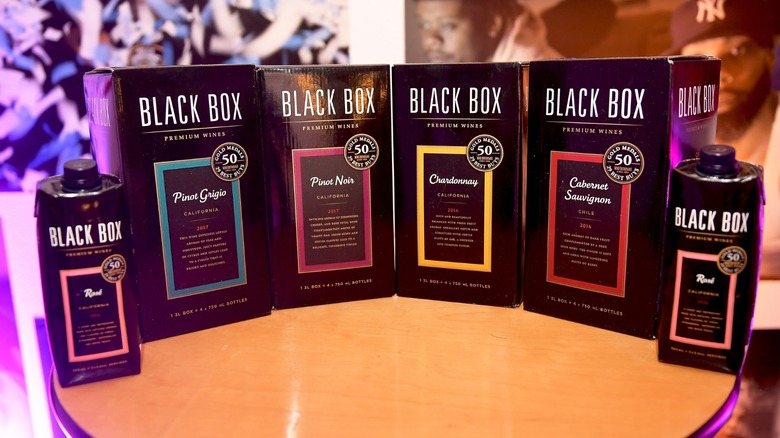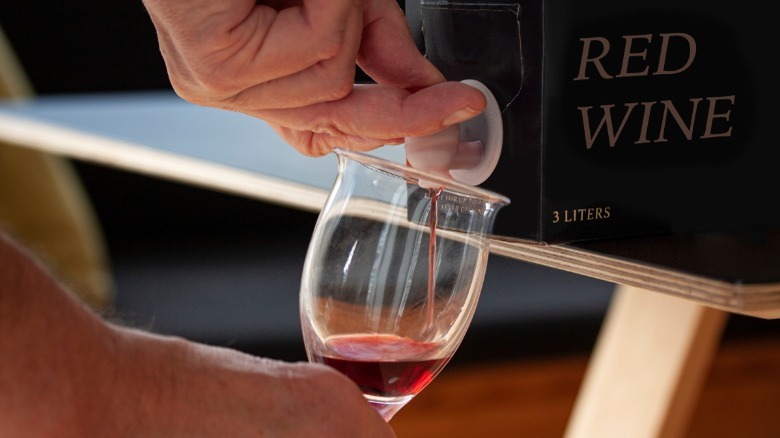How Many Glasses Of Wine Are In A Standard Box?
Your eyes may gloss right over them, but boxed wines remain a staple on liquor store shelves. Though bottles are sometimes considered the more aesthetically pleasing and sophisticated choice, they can be a hassle to reseal, and aren't as convenient as the boxed variety if you're tending to a crowd. So, if you're looking for an easy way to entertain the masses — or simply just enjoy the flavor of boxed wine — how many glasses will you actually get out of a standard box?
Boxed wine is typically three liters in volume, or around 33.8 fluid ounces, and the standard pour for a glass of wine is five ounces. Doing the math, that means one box of wine should provide you with around 20 glasses. Some brands, like Franzia, sell a five-liter box of wine for under $20, which is even more bang for your buck — five liters amounts to approximately 170 ounces, or around 34 glasses of wine. In comparison, a standard 750-milliliter bottle of wine will only get you about five glasses and can cost the same, if not more than, a box. Of course, all the measurements are subject to how much you truly pour — some people stick to the recommended serving size, but others like a heftier glass (or two).
Are there benefits to boxed wine?
Besides being able to pour more glasses for less money, there are benefits to purchasing wine in its boxed form. One of the biggest pluses is that it stays fresh longer than bottled wine. For example, a bottle of red wine typically lasts a maximum of five days once you've opened it, but boxed wine can often keep for up to eight weeks — or longer if you store it in the fridge.
Its preservability comes down to the storage system within the box. Inside the cardboard walls, the wine is held in a bag made of polyethylene plastic that's sealed with a tap (where the wine comes out). The tap prevents air from coming in, and the cardboard shell surrounding it all keeps out light that could harm the wine. This combination allows the wine to be optimally preserved and consumed for weeks after you open it. The box system also lets you bypass the cork, and that awkward moment where you have to figure out what to do when your wine is full of broken cork pieces.
If that wasn't enough to convince you, boxed wine is better for the environment. Bottled wines actually make up a significant portion of the wine industry's carbon footprint — although aluminum bottles could be an eco-friendly solution as well. Many boxes are made of recycled cardboard, which significantly reduces waste compared to bottles.
What are some good boxed wine options?
There are many redeeming qualities of boxed wine, and you might be wondering which variety to reach for when prepping for your next gathering — because truly, there are plenty of boxed wines that do not suck. Generally, wines are rated on a 100-point scale, where lower scores correlate with lesser quality wines. According to wine experts, boxed wine can reach the 85 to 90-point mark, so it's really time to discard the stereotype that all boxed wines are bad.
Despite its many benefits, a corkless cardboard box isn't the best place to properly mature wine. So, your best boxed bets, if you're particularly concerned about quality, are wines like zinfandel or pinot grigio rather than pinot noir or cabernet — the latter two improve with age. However, if you prefer red wine, there are a number of boxed blends that deliver a bold flavor regardless of their maturity. Bota Box's Nighthawk Black is a popular option, and even Franzia's Red Blend has been recognized as a fan favorite. If the eco-friendly aspect of boxed wine is especially important to you, choose a brand that uses sustainably grown grapes. Bridge Lane is an excellent example that sells boxes ranging from rosé to chardonnay, and Gratsi is a Mediterranean-inspired retailer that also employs sustainable practices.



